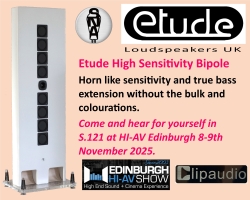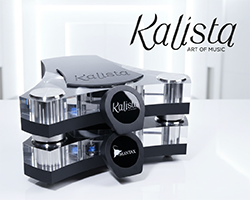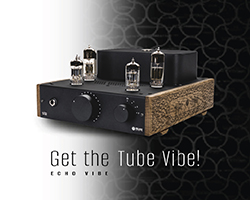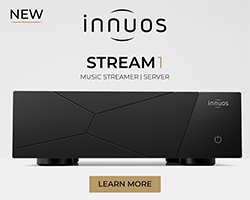French company Metronome Technologies make a whole host of kit for the digital domain, here Stuart Smith tries out their AQWO CD/SACD player and DAC with valve output stage costing £13,870 Euros as tested.
 Metronome Technologies is a French brand you may or may not be aware of, but they have been in existence for over thirty years, they were founded in 1987, and if you have ever seen the Kallista DreamPlay CD (yes, that’s one of theirs too, though you won’t find it on the Metronome website oddly) you will certainly remember its massive aluminium and methacrylate structure – it’s one of those “once seen, never forgotten kind of products” that just screams high-end luxury. Despite having manufacturer amplifiers, speakers and other products, they now concentrate on products aimed at reproducing high-resolution music and formats with their product range including DACs, CD Transports, Integrated DAC/CD Players and in 2016 they launched new servers, all of which are distributed in the UK by Absolute Sounds (interview with Ricardo of Absolute Sounds here). The philosophy here is to produce high-quality products capable of reproducing to the highest standards the latest, and legacy, formats. All Metronome’s products are hand-crafted and overseen by the company’s engineers to ensure the best performance and build quality.
Metronome Technologies is a French brand you may or may not be aware of, but they have been in existence for over thirty years, they were founded in 1987, and if you have ever seen the Kallista DreamPlay CD (yes, that’s one of theirs too, though you won’t find it on the Metronome website oddly) you will certainly remember its massive aluminium and methacrylate structure – it’s one of those “once seen, never forgotten kind of products” that just screams high-end luxury. Despite having manufacturer amplifiers, speakers and other products, they now concentrate on products aimed at reproducing high-resolution music and formats with their product range including DACs, CD Transports, Integrated DAC/CD Players and in 2016 they launched new servers, all of which are distributed in the UK by Absolute Sounds (interview with Ricardo of Absolute Sounds here). The philosophy here is to produce high-quality products capable of reproducing to the highest standards the latest, and legacy, formats. All Metronome’s products are hand-crafted and overseen by the company’s engineers to ensure the best performance and build quality.
BUILD AND FEATURES
Here with the AQWO we essentially have a CDC+SACD/CD drive along with a DAC which will handle DSD up to 512 (x8) – actually this is the first time Metronome have ventured into the realms of an SACD player. It’s a top loader that uses a professional drive mechanism from D & M (look them up, you may not know the name but you will know the brands) that has been breathed on by Metronome’s engineers, with the mechanism being centre of the top plate and using a Delring clamp that clicks beautifully and securely into place with a magnetic snap. It’s that kind of feeling you get when you move from a good but basic car when you close the doors to a quality car whose doors close with a reassuringly solid feel and satisfying clunk. Certainly, the unit oozes quality from the outset of the package arriving – packaging is great and fantastically secure, internal packaging is likewise beautifully done ensuring that the machine arrives in one piece and ready to play music. Taking the AQWO out the box is no mean feat as it weighs a not inconsiderable 15Kg.
Inside the beautifully finished aluminium box, you have two internal DACS (AK4497) made by Asahi Kasei Microdevices Corporation from Japan. The chips were introduced at CES in 2016 with full production beginning in the Summer of 2016. The AK4497 uses new circuit design techniques and manufacturing processes and has onboard six different digital filter types which are selectable according to user/system preferences.
Special attention has been given over to the power supplies used in AQWO using separate power regulation lines and individual toroidals with the aim being to protect from EMI and RFA, decrease vibration and aid rapid power transitions. Indeed, there are three toroidals with no less than ten independent regulation lines. All PCBS used are soldered in Metronome’s own workshops.
The review unit arrived in silver but a black version is also available. Round the back and looking left to right you have:
Master power switch
IEC Inlet
2 x AES/EBU XLR inputs
2 x SPDIF RCA inputs
2 x Toslink inputs
USB Input
Outputs include:
Toslink, SPDIF, AES/EBU and HDMI12S plus balance and single-ended analogue outputs using the usual RCA and XLR connections.
All inputs and outputs are well labeled and easy to read in a distinctive blue on black livery.
This comprehensive array of inputs and outputs allows the AQWO to be used in a variety of configurations: All-in-one SACD/CD and DAC player, dedicated standalone SACD/CD transport or standalone DAC. For most I think the unit is likely to be used either as an all in one DAC and transport with the added benefit of being able to use the onboard DACs with a host of other out-board devices, be that a laptop running your favourite music software (the unit comes bundled with drivers for Foobar), and external CD player/games machine/streamer/whatever. It’s a well-connected unit that offers itself up as the hub of your digital universe. The only thing missing, and this is catered for with other Metronome units, is a network connection to allow direct streaming from a home network…but then add a computer and you have that anyway.
The unit measures 425 x 130 x 415mm with the front panel being dominated by a large 6.5” touchscreen which I personally thought was a very nice touch (no pun intended) – more on this later. A nice and simple remote control is also included.
So, before you even think about plugging in the AQWO to the mains supply, the vibe is positive with a feeling of over-engineered loveliness that is the epitome of understated yet solid design and engineering. When you take a step back to admire the unit on the rack, it is only then that you notice the massive spiked feet which support the AQWO’s mass.
SOUND QUALITY
I wanted to use the AQWO in the way that I think it will be most likely used and in the first instance this is an all in one CD/SACD player and DAC to my mind. First on the platter is the musically superb Babes Never Die by Honeyblood whose first and title track sounds fab in the car, but on any system that has any resolution at all sounds muddy, muddled and generally horrible. With the AQWO I was as disappointed as I have previously playing this CD in the house, suggesting that the Metronome unit isn’t going to allow a sow’s ear to be magically crafted into a silk purse – perhaps I’m missing the production values in this record, though I strongly suspect not! I don’t like products that make clearly badly produced records sound somehow and magically better – this suggests to me that a product is not truly High Fidelity and is fudging something along the way.
Changing discs is an absolute pleasure on the AQWO, with the sliding top mechanism having that same satisfying expensive car door closing feel to it as I mentioned. And the remote is perfectly useable too – simple, nice enough, not too generic looking (we’ve had some horrors arrive at Hifi Pig Towers) – it does its job.
And so, in comparison to the above, we have the brilliant Leftfield and their Rhythm and Stealth. It’s a very well-produced record that demands to be listened to on a great system to get the very best from it. It’s deep, complex and with textural elements that can become lost on lesser systems. What the AQWO manages to do is bring out the layers of the mix and present them in a cohesive and intelligible stream for the speakers to project into the room. And it’s all there too, micro-detail is probably what more verbose review-bods may likely call it, but I like that the AQWO is able to bring a feel of texture and detail to proceedings with you being able to hear what effects etc have been added to certain sounds such as electronic kick. This kind of music can often become muddled on some systems, it’s not the recording, rather it is the electronics used to decode those zeros and ones’ inability to make sense of those digits that makes a mess of it. The AQWO performs brilliantly here portraying and laying before the listener coherence and subtlety, whilst at the same time not getting phased by the dynamic shifts in the music. There is a feeling of solidity to proceedings with this kind of program that inspires confidence and, it must be said, to shake one’s ass! This is a good thing! Often a piece of electronics can come in for review and whilst it sounds accurate and whatnot it doesn’t make you want to move and really get down with the grooves – not so here.
On acoustic material, I’ve plucked Neil Young’s After The goldrush out of the many albums I played for the purposes of the review, and again the AQWO shines. There is detail and accuracy in the, let’s face it, less than perfect voice of Young that lets the emotional feel of this record come to the fore and AQWO hides none of it, but without that overly bright trick used by some to highlight upper-end detail – another pet hate of mine. To me, the music should be presented to you as near to the original as is possible and I think this is what this box of tricks manages to achieve. DAVE from Chord Electronics is perhaps more detailed in a real sense than the Metronome unit and the Lampizator Big 7 is perhaps more musically engaging, but what the AQWO manages to do is fall somewhere in the middle, allowing for an emotionally engaging listen that sounds very detailed and resolved without being too much – to these ears anyway. Don’t get me wrong, DAVE is THE best DAC I’ve heard in our system and the Lampizator BIG 7 remains our reference in the big system, but this is a very enjoyable CD/DAC to listen to. Easy going and yet detailed is perhaps the best way to describe it.
TUBE OUTPUT
On the touch screen is a little virtual button in the shape of a vacuum tube/valve which is used to engage or disengage the tube output section. “The tube output section consists of 2 JAN6922 using a Class A polarisation diagram with a high bandwidth,” says the bumph from Metronome. Push the button and there is a more “rounded” sound without it being rolled off in the top-end if that makes sense. I confess to having preferred the sound with the tube section engaged, feeling that it seemed a little more natural sounding – I categorically refuse to say it made it sounds more analogue, but I know for certain that that is exactly what some reviewers will say about this.
FILTERS
To access the available filters on the AQWO simply press the logo for a second or two and the menu page opens up – you can also change the voltage output here as well as the main colours of the screen. A short press on the logo allows you to dim or turn off the screen. It’s on this screen you can enable or disable inputs too. Filters available on the AQWO are a Sharp Roll-Off, Slow Roll-Off, Super Slow-Roll-Off, Short Delay Sharp Roll-Off, Short Delay Slow Roll-Off and Low Dispersion Short Delay which each have an effect on the final sound – though I’ve tended to find that digital filters on DACS tend to be useful in “taming” the digitalness ( I know it’s not a real word) of hi-resolution recordings and the same is here. Users will find one they like and tend to stick with it I would suggest.
USING AN EXTERNAL CD TRANSPORT
This is an interesting one for me as I had in the dim and distant past been of the opinion that the most important bit of a CD was the DAC being used, and I do believe that this is true – to an extent. In recent years I’ve played around with a number of transports into our DACs and each has a greater or lesser effect on the overall performance. Using our Leema Elements CD player and Musical Fidelity Tri-Vista 3D as transports into the AQWO highlighted that whilst the DAC on the AQWO does, in my opinion, have the biggest effect, the transport used betters the two transports we have to hand and by a good margin. The effect I got using the transport in the AQWO over the other two was a perceived increase in stability of stereo image and a “cleaner” overall presentation. With this in mind, I cannot wait to hear what the company’s bigger (and much more expensive) transports are capable of. So, if the onboard transport is so good then why bother having the digital inputs (I’m not talking about the USB input here)? Well, they are useful if you have other digital sources that you want to put through the AQWO – I’m thinking DVD players, games consoles and the like as I mentioned earlier. This way the AQWO becomes more than a CD/SACD drive, it becomes more of a digital hub for your home.
USB INPUT
Download the drivers (usual procedure), select the relevant output on your Windows machine and off you go. I sued to have a great deal of trouble with drivers but once you get your head around having to install them then all is good.
Playing DSD files (I only have a few to be fair) from the computer and via USB is pretty revealing. The detail and depth of the files are well evident and sound fabulous. Jazz At The Pawnshop (yeh, I know it’s a cliché) is brilliantly portrayed on DSD and there is that real “I’m in the venue” feel. The recording is like that anyway but the AQWO adds another layer of realism to the recording – or perhaps that should be the Aqwo strips way any layers that are getting in the way of the realism of the recording. Again we have beautiful depth to the recording which envelopes the listener and transports them to 1976 and the venue – I’ve never seen pictures of the inside of the venue but sat here listening to this album on the AQWO I see in my mind’s eye a fairly intimate and smoky venue, that is warm and buzzy to combat the cold December weather outside. And here is one of the key characteristics of the AQWO – it has an uncanny ability to make sense of a recording and to set before the listener a realistic portrayal of the space and music without taking anything away or embellishing it.
Other files of varying resolution all play perfectly and are converted to music without hassle and with the same kind of results I’ve outlined earlier.
CONCLUSION
The AQWO is a fine machine that sounds absolutely wonderful. It is accurate without being fatiguing on everything we threw at it other than poorly recorded music which it makes no excuses for – if you have a load of dodgy MP3s etc then this is not going to be for you – that said, you are unlikely to be the kind of person to spend this kind of money on a CD player and DAC and then go steal dodgy files. Hi-resolution music sounds sublime on the AQWO and it is to this market that I believe it is aimed.
CD, it is often claimed, is a medium in decline but I’m of the opinion that CDs often represent great value for money and I’m still out there buying them in larger numbers than I ever have and I believe they will be around for a good deal of time to come. It is fantastic to see a company have such dedication to the format and to include the SACD format too, which sounds great to these ears. However, what Metronome has done is incorporate so much more into this unit taking it beyond mere CD/SACD player and to the realms of being, as I’ve mentioned a couple of times already, the heart of a digital playback system that is as up to the rigours of dealing with the new-fangled hi-res file formats as well as playing the CDs and SACDs you already own or will own.
I highly commend the AQWO and in many ways wish I could have justified having another CD player and DAC in the system – actually I did justify it but was told we need a new kitchen…
If you are in the market for a DAC then check the AQWO out. If you are in the market for a CD/SACD player then check the AQWO out. Really, this unit offers so much in terms of sonic enjoyment and flexibility that t should be high on anyone’s list of must audition pieces if you have the price of entry.
AT A GLANCE
Build Quality: Superb. Not a lot to add other than to say this is like stepping into a Mercedes after being in a Peugeot.
Sound Quality: Unforgiving on poor recordings but fantastically engaging and connecting on well-recorded files and CDs. Fatigue-free listening whilst being wonderfully detailed.
Value For Money: It’s not cheap by any stretch of the imagination, but then neither are Mercedes.
Pros: Build quality. The flexibility of inputs and outputs. SACD onboard. Great sound.
Cons: All I can genuinely think of is its price which may be off-putting for some.
Price: 12,800.00 euros, and the tube output option is 1,070.00 euros
Stuart Smith

Review Equipment: Merrill Thor amplifiers, Music First Preamplifier, Avantgarde Duo XD speakers, Tellurium Q speaker cables and interconnects, Quadraspire rack. Leema Elements and Musical Fidelity Tri Vista CD pLayers, Xavian Perle loudspeakers, Graham Slee Proprius Amplifiers, Lab 12 preamplifier, Chord Company interconnects and speaker cables, Hifi Racks Racks.



















































































































































































































You must be logged in to leave a reply.